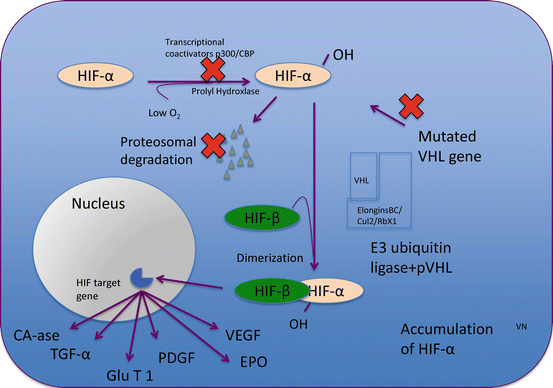Fig. 18.1
Cellular function with normal O2 levels and normal VHL System
When there is hypoxia or mutation of pVHL, binding of pVHL to HIF-α cannot occur and the pVHL-HIF complex is not formed leading to accumulation of HIF-α. After escaping the proteolytic pathway HIF-α gains access to the cellular nucleus to bind with HIF-β and induce gene activation to restore normoxic conditions. There is upregulation of a variety of proangiogenic and growth factors, including vascular endothelial growth factor (VEGF) and platelet-derived growth factor (PDGF) involved in angiogenesis, transforming growth factor-α (TGF-α) involved in autocrine and paracrine growth stimulation, on glucose transport (Glut-1), and erythropoietin (EPO), which are all believed to play critical roles in the development and progression of ccRCC (Fig. 18.2).


Fig. 18.2
Target gene activation in VHL loss
While most contain mutation of the VHL gene, it seems likely every tumor has its own unique genetic signature. Molecular analysis continues to search for these other genetic alterations. To date, more than 1,500 germline and somatic mutations have been sequenced from the three exons of the VHL gene [31]. Excluding 3p deletions, loss of genetic material and heterozygosity affecting chromosomes 14, 8, 9, and 6 has been is found in 20–40 % of RCC [21]. Other tumor suppressor genes implicated in RCC include p53 on 17p, Rb(Retinoblastoma) on 13q, p16INK4a/p14ARF on 9p and PTEN on 10q [21]. The latter is of significance for targeted therapy as the PTEN protein inhibits phosphatidylinositol-3-kinase dependent activation of protein kinase B. Loss of this protein leads to consecutive activation of the mTOR-pathway which promotes tumorigenesis [32].
References
1.
2.
3.
4.
Chow WH, Devesa SS. Contemporary epidemiology of renal cell cancer. Cancer J. 2008;14:288–301.PubMedCentralPubMedCrossRef
5.
6.
7.
8.
9.
Adams KF, Leitzmann MF, Albanes D, et al. Body size and renal cell cancer incidence in a large US cohort study. Am J Epidemiol. 2008;168:268–77.PubMedCentralPubMed
< div class='tao-gold-member'>
Only gold members can continue reading. Log In or Register to continue
Stay updated, free articles. Join our Telegram channel

Full access? Get Clinical Tree






